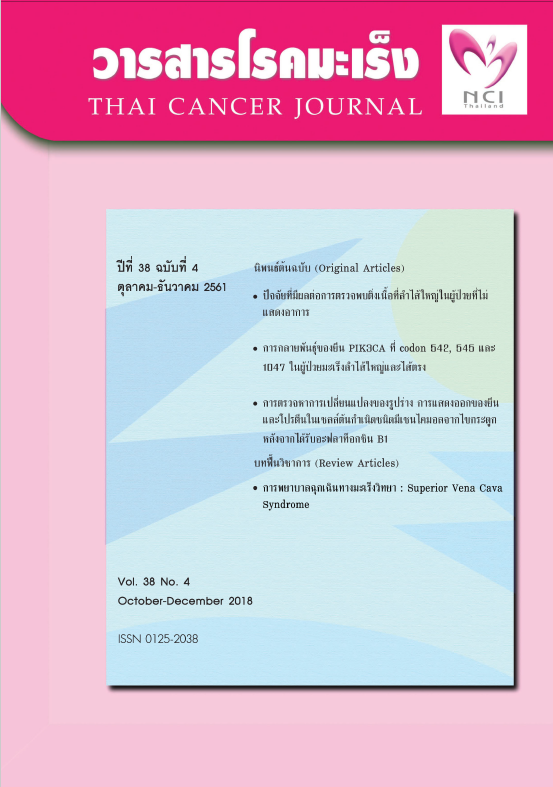Factors Associated with Colonic Polyp Detection in Asymptomatic Patients
Keywords:
CEA, colonic polyp, dysplasia grading, colorectal cancerAbstract
Currently, increasing numbers of people are seeking medical advice for screening colorectal cancer. One of the reasons for patients' deciding to undergo colonoscopic examinations has been the detection of high serum carcinoembryonic antigen (CEA) levels. This study aimed to evaluate the factors associated with the detection of colonic polyps and the association between high CEA level and type, number, and dysplastic grading of polyps. This was a cross-sectional descriptive study of asymptomatic patients who visited the gastrointestinal clinic at Lopburi Cancer Hospital for annual check-ups, from July 2015 to July 2017. In all, 238 patients (118 male; 120 female) were included. The mean patient age+ standard deviation was 58.1+10.6 years. The results showed elevated CEA level was more common in the male group than the female group (62.8 and 37.2%, respectively; P=0.004). Elevated CEA level was statistically significantly higher in the smoking group than the non-smoking group (P=0.000). In addition, the ages of the group without polyps were younger than the other groups (non-advanced adenoma, advanced adenoma, and malignancy groups) (55.08+10.7, 59.34+9.35, 64.39+9.16, and 62.00+4.96 years, respectively, P=0.000). Regarding CEA level, a normal colonoscopy finding mainly (60.6%) occurred in the normal CEA level group. Nevertheless, more patients with non-advanced adenoma, advanced adenoma, and malignancy, had elevated CEA levels (37.2%, 17.9%, and 6.4%, respectively) than groups with normal CEA (24.4, 14.4, and 0.6, respectively, P=0.002). CEA level did not correlate with number of adenomatous polyps (P=0.959). However, elevated CEA was associated with high-grade dysplasia of adenomatous polyps (P=0.039).
References
สถาบันมะเร็งแห่งชาติ กรมการแพทย์ กระทรวงสาธารณสุข ทะเบียนมะเร็งระดับโรงพยาบาล พ.ศ. 2559 Hospital-Based Cancer Registry Annual Report 2016. กรุงเทพฯ: บริษัทพรทรัพย์การพิมพ์จํากัด; 2561.
Bibbins-Domingo K, Grossman DC, Curry SJ, Davidson KW, Epling JW Jr, García FAR, et al. Screening for Colorectal Cancer: US Preventive Services Task Force Recommendation Statement. JAMA 2016;315:2564-75.
Rex DK, Boland CR, Dominitz JA, Giardiello FM, Johnson DA, Kaltenbach T, et al. Colorectal Cancer Screening: Recommendations for Physicians and Patients From the U.S. Multi-Society Task Force on Colorectal Cancer. Gastroenterol 2017;153:307-23.
Wilt TJ, Harris RP, Qaseem A. Screening for cancer: advice for high-value care from the American College of Physicians. Ann Intern Med 2015;162: 718-25.
Rex DK, Johnson DA, Anderson JC, Schoenfeld PS, Burke CA, Inadomi JM. American College of Gastroenterology guidelines for colorectal cancer screening 2009 [corrected]. Am J Gastroenterol 2009; 104:739-50.
Burt RW, Barthel JS, Dunn KB, David DS, Drelichman E, Ford JM, et al. NCCN clinical practice guidelines in oncology. Colorectal cancer screening. J Natl Compr Canc Netw 2010;8:8-61.
Winawer SJ, Zauber AG, Ho MN, O'Brien MJ, Gottlieb LS, Sternberg SS, et al. Prevention of colorectal cancer by colonoscopic polypectomy. The National Polyp Study Workgroup. N Engl J Med 1993;329: 1977-81.
Han PK. Historical changes in the objectives of the periodic health examination. Ann Intern Med 1997; 127:910-7.
Boulware LE, Marinopoulos S, Phillips KA, Hwang CW, Maynor K, Merenstein D, et al. Systematic review: the value of the periodic health evaluation. Ann Intern Med 2007;146:289-300.
Fenton JJ, Cai Y, Weiss NS, Elmore JG, Pardee RE, Reid RJ, et al. Delivery of cancer screening: how important is the preventive health examination? Arch Intern Med 2007;167:580-5.
Gold P, Freedman SO. Demonstration of tumorspecific antigens in human colonic carcinomata by immunological tolerance and absorption techniques. J Exp Med 1965;121:439-62.
Gold P, Freedman SO. Specific carcinoembryonic antigens of the human digestive system. J Exp Med 1965;122:467-81.
Shahangian S, Fritsche HA, Hughes JI. Carcinoembryonic Antigen in Serum of Patients with Colorectal Polyps: Correlation with Histology and Smoking Status. Clin Chem 1991;37:651-5.
Sturgeon CM, Lai LC, Duffy MJ. Serum tumour markers: how to order and interpret them. BMJ 2009; 339:b3527.
Tumour marker requesting. Guidance for non-specialists; Pathology Harmony, June 2012
Fletcher RH. Carcinoembryonic antigen. Ann Intern Med 1986;104:66-73.
Sturgeon CM, Duffy MJ, Stenman UH, Lilja H, Brunner N, Chan DW, et al. National Academy of Clinical Biochemistry laboratory medicine practice guidelines for use of tumor markers in testicular, prostate, colorectal, breast, and ovarian cancers. Clin Chem 2008;54:e11-79.
Fakih MG, Padmanabhan A. CEA monitoring in colorectal cancer. What you should know. Oncology (Williston Park) 2006;20:579-87.
Duffy MJ. Carcinoembryonic antigen as a marker for colorectal cancer: is it clinically useful? Clin Chem 2001;47:624-30.
Tong J, Wang Y, Chang B, Zhang D, Wang B. Associations between tumor markers and the risk of colorectal polyp recurrence in Chinese people. Int J Clin Exp Med 2015;8:6397-405.
Doos WG, Wolff WI, Shinya H, DeChabon A, Stenger RJ, Gottlieb LS, et al. CEA levels in patients with colorectal polyps. Cancer 1975;36:1996-2003.
Lee JH, Hong SP, Jeon TJ, Kang GH, Choi WC, Jeon SM, et al. Should a colonoscopy be recommended for healthy individuals with increased carcinoembryonic antigen levels? A case-control study. Dig Dis Sci 2011;56:2396-403.
Levi Z, Rozen P, Hazazi R, Vilkin A, Waked A, Maoz E, et al. Sensitivity, but not specificity, of a quantitative immunochemical fecal occult blood test for neoplasia is slightly increased by the use of low-dose aspirin, NSAIDs, and anticoagulants. Am J Gastroenterol 2009;104:933-8.
Fischbach W, Mossner J. Do size, histology, or cytology of colorectal adenomas and their removal influence serum CEA? Dis Colon Rectum 1987;30: 595-9.
Downloads
Published
Issue
Section
License
บทความทีตีพิมพ์ในวารสารโรคมะเร็งนี้ถือว่าเป็นลิขสิทธิ์ของมูลนิธิสถาบันมะเร็งแห่งชาติ และผลงานวิชาการหรือวิจัยของคณะผู้เขียน ไม่ใช่ความคิดเห็นของบรรณาธิการหรือผู้จัดทํา







